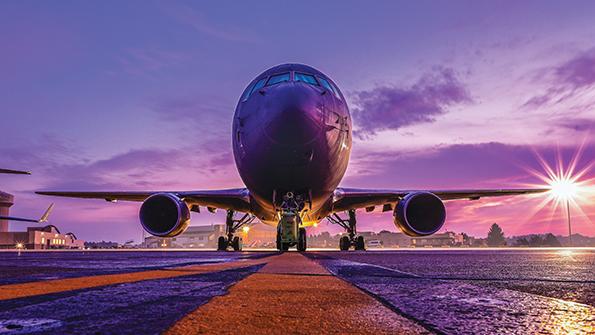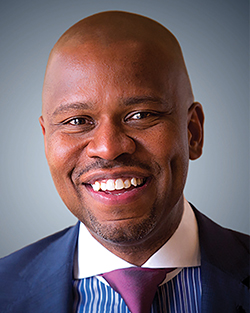Boeing’s Colbert Gears Up For Next-Generation Competitions

Aside from a recent fuel tank issue, Boeing is meeting performance projections on its KC-46 tanker program, Colbert says.
Ted Colbert, president and CEO of Boeing Defense, Space and Security, spoke with Aviation Week editors Jen DiMascio, Steve Trimble, Brian Everstine and Joe Anselmo about his focus on regaining stability on the company’s major development programs after the COVID-19-related workforce and supply chain issues, while eyeing future fighter, tanker and vertical lift business.
- Colbert “intends to be ready” for next-generation fighter business
- Future of vertical-lift facility is a priority
AW&ST: What grade would you give yourself in your first year on this job? I’d say in a B/B- range. I’d love to be an A+ all-star. I don’t know if you ever get there in an industry this hard. [If] I had it my way, we would be recovering the supply chain much faster than it’s recovering right now from the pandemic. If I had it my way, we would’ve been able to settle down the workforce churn even faster. We have to start programs right in contracting. For the E-7 Airborne Early Warning and Control contract [and] the AH-64 Apache multi-year contract, we sat down with our customer and with bidirectional transparency are trying to set these programs up for success. This is about running a healthy business.
How far are you from where you want to be? You’re starting to see metrics showing a more stable workforce in the factory. That is a marked improvement over 12 months ago. In the supply chain, we’ve deployed several hundred of our own teammates into critical suppliers to help them with requirements. And we are doubling down on standards like Advanced Product Quality Planning. When we have done the work, we see quality improved. We also have had one-time issues, like the Daher issue we had on the KC-46 with the fuel tank. That’s not helping us get to where we want. But if you take away the notice of statement we had on that program, the actual unit-hour performance that we projected last year, we are right on the mark. The MQ-25 [aerial refueling uncrewed aircraft system], VC-25B [presidential transport] and T-7 [advanced trainer]—they are development programs. We’ve still got to build some of them. We still have to fly and test. Having an intense continuous improvement culture in place will be needed to mitigate findings we have through the development program. That’s just real. That’s how these big programs operate.
U.S. Air Force Secretary Frank Kendall has proposed an acquisition strategy of continuous competition among airframe companies for the Next-Generation Air Dominance program. How are you preparing for that? We have a strong legacy in the fighter business and are going to continue to invest in that business. The F-18 and F-15EX are still strong platforms, but we’re also investing in the future. We have new sites coming up in St. Louis to support the next generation of air dominance. We have a center out in Mesa, Arizona. We have an investment strategy that matches what we see as the next-generation types of capabilities to support air dominance. And as, and when, the customer executes on the way forward, our intent is to be ready for it.
What’s the vision for vertical lift and Boeing? We have Apache orders in play, several hundred. We have Chinook orders coming through as well. Not huge orders, but there’s activity. On the V-22, we’re working through, with the government, a single-digit number of orders. If I pull up from that, we’re having a discussion with our customers on shaping the future of vertical lift in ways that make sense. Is there more we can do to evolve Apache for the future?

We have technical and engineering expertise on vertical takeoff and lift that we could take advantage of in the long run. The Philadelphia site has a great talent base that can do more than just assemble and build vertical lift capabilities. I can’t give you the full story right now, but from a strategic perspective, thinking about vertical lift and the site implications around vertical lift is a top priority.
When do you expect KC-46 deliveries to resume? As soon as possible. We have a schedule that we are adjusting every single day. I’ve spoken with the team, with Daher leaders every day; we are all connected. This is moving at a decent pace. We haven’t come off our commitment to the customer this year, so obviously that puts a lot of pressure on us in the third and fourth quarter. But we believe the work we’re doing to mitigate that pressure right now hopefully will come home—and if it doesn’t, it’ll be for all the right reasons, which are safety and quality.
How is Boeing thinking about future refueling tankers and airlift? What is Boeing’s interest in blended wing body concepts? We are staying very close to the Air Force and the Defense Department on future requirements. One of the beautiful things about our company is its engineering capability and talent around blended wing bodies—the commercial and defense side of the business. As we understand more about the requirements, we’ll want to be a part of how that plays out. I’m hoping that we get into a more agile process with our customers on future capabilities because it allows us to shape all our investment in the right way. We want to get very iterative on how we develop capabilities. If there’s a dimension or an attribute of that future platform that we’re expert in, we’re going to be right there, and we’re going to go find partners in areas where we aren’t experts.
What do you think of this JetZero project to develop a military tanker that’s repurposed into a midmarket airliner? It’s fascinating. We are in the derivatives business. And can you go both ways? Maybe you can. The underlying technologies, the mission systems, we know a lot about, and we have partners who know a lot. We wouldn’t take something like this completely off the table, because the opportunity here to drive economies of scale—great synergies from a technology perspective, taking advantage of all we’re learning around artificial intelligence and autonomy—are huge. I think we are most uniquely situated to bring together commercial and defense types of capabilities and in a way that no one else really can do. I don’t write any of this stuff off.
How will space be a growth area for Boeing? Our satellites are launching. We just had some Viasat launches, and we’re proud of those. We have O3b sending and receiving signals. Our satellite factory is getting its mojo back after the pandemic. For both commercial and government satellites, I think we have a lot to offer. Our acquisition of Millennium Space [Systems], a smallsat company, has a lot of opportunity [(AW&ST May 22-June 4, p. 38)]. It’s more government--proprietary-based, but learning from their approach, leveraging their technologies and capabilities in the long run is an important strategic area of focus. [The Space Launch System], obviously, we had a great launch last year. And [the CST-100] Starliner will have a crewed mission later this year, and we’re excited about that. NASA just laid out their whole future Moon and Mars mission strategy. I won’t go into details, but we’re working through how we fit into that.
If Ukraine needs two or three future squadrons of fighters, and Lockheed Martin has limited F-16 production capacity, why not pitch: “Hey, we’ve got some capacity here”? Our intent is to support the fight in Ukraine in the way that the U.S. government, the Defense Department and the Ukrainians want to fight. If that’s a path that either or both want to go down or the U.S. government wants to go down, then that’s a good discussion. We stay connected on this very closely.
We’ve heard the Pentagon talk a lot about supply chain shortages for things such as solid rocket motors and ball bearings. What have you learned about the supply chain for munitions? It’s an interesting set of challenges and problems to solve, and you have to take it methodically. You have to model the supply chain, find where the constraints are and then start investing or creating multiple suppliers or updating technologies. We’re doing all of that right now. Many of the capabilities we have are enduring, and they work really well. Then you have to make a decision: Are you going to increase the rate of manufacturing, or are you going to develop something new that operates in a different way?
Will you change the strategy that Boeing has had of offering low bids and taking charges in development? Can Boeing afford to do that now? I wouldn’t expect you to see us doing that anytime soon. It is about understanding the requirement from the customer, defining our capabilities, being massively transparent about the cost profile, being very realistic about the maturity of the technology and the producibility of whatever the thing is, and building up a program and profile that takes those things into consideration. We have got to drive discipline in that process. It is good for us, it’s good for our customer, it’s good for the taxpayer.
In 2008, Patrick Shanahan was hired from the Missile Defense Agency to fix Boeing Commercial’s 787. You came in last year with five fixed-price development programs facing different levels of schedule and cost pressures. How do you see the things that are outside of your control, things that you inherited internally and the external issues that are part of all these programs? I was part of that 787 team. So I’ve seen this movie before, getting the stability. You understand what you control and what you don’t control. What I can control is the stability of the workforce, the training and proficiency of our teammates on the factory floor. Execution of our lean best practices. Having a strong culture within the team. Engaging well with the customer and being transparent. We are well on our way to the path of improvement on our programs. The supply chain is going to be bumpy for a while. Because we are so transparent these days, you are going to hear more about it than you ever heard before. Back to my time with the commercial folks. The first place I started was in a war room that laid out the plan, it laid out the program and helped me understand where I needed to go to help them drive productivity. In my old job, I knew exactly where I needed to help them drive productivity. That’s the same approach we’re taking.




